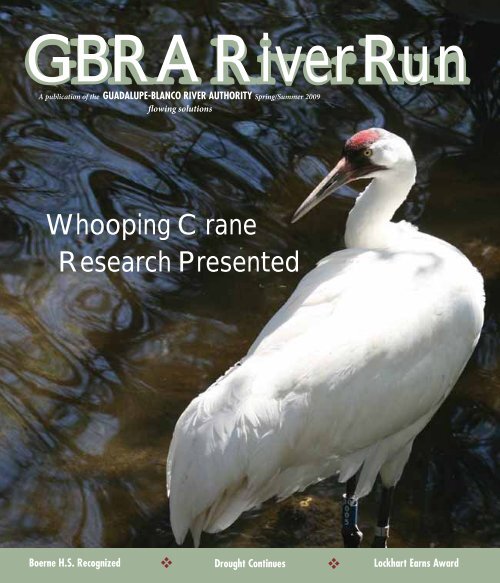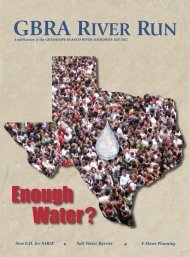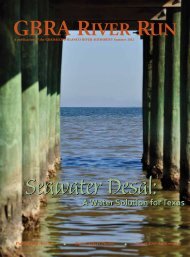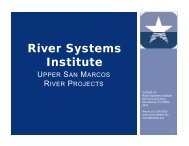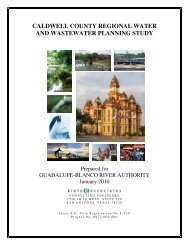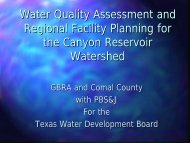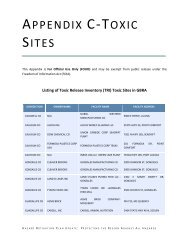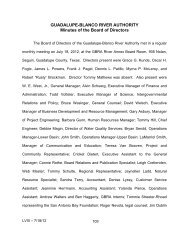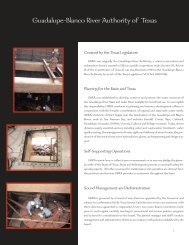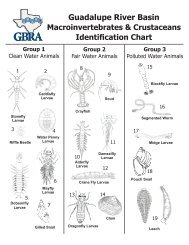Summer 2009 - Guadalupe-Blanco River Authority
Summer 2009 - Guadalupe-Blanco River Authority
Summer 2009 - Guadalupe-Blanco River Authority
- No tags were found...
Create successful ePaper yourself
Turn your PDF publications into a flip-book with our unique Google optimized e-Paper software.
Lab Director Earns Excellence AwardJosephine “Josie” Longoria, regional laboratory director at the<strong>Guadalupe</strong>-<strong>Blanco</strong> <strong>River</strong> <strong>Authority</strong> (GBRA), was honored withthe 2008 Laboratory Analyst Excellence Award by the WaterEnvironment Association of Texas (WEAT).The WEAT Laboratory Analyst Excellence Award recognizesan individual for outstanding performance, professionalism, andcontributions to the water quality analysis profession. Longoria earnedrecognition because of her extensive involvement in the education ofher peers in the science and water resources community while takingon leadership roles with enthusiasm and dedication. Formal recognitionfor WEAT awards occurred at Texas Water <strong>2009</strong>.“WEAT is pleased to recognize Ms. Longoria for heraccomplishments and service to the water utility laboratoryprofession,” said Carol Batterton, WEAT’s executive director. “Ourorganization is fortunate to have such a dedicated professional in thisimportant area.”Longoria began her career after graduating from West Texas A&MUniversity with a degree in Biology and Chemistry. Her 16 years in thelab have included working for the Texas A&M Extension Lab, the A&LAgricultural Lab, as well as the South East Water Reclamation PlantLaboratory in Lubbock, Texas.After joining the GBRA in 2002 as a laboratory analyst, Longoriaeventually was promoted to regional laboratory director in 2003. Shewas instrumental in organizing the GBRA Regional Lab’s first attemptin acquiring its NELAC accreditation for both drinking water andwastewater. Longoria described the task as a monumental undertaking,requiring her to act as a quality assurance officer and lab director.“Ms. Longoria is a dedicated professional working every day toprotect the natural resources of our basin and promote the laboratoryanalyst profession,” said Debbie Magin, GBRA director of water quality.Longoria hasalso assisted withaddressing the NELACInstitute requirementsin Texas. She has beeninvolved in the TexasWater OperationsChallenge, a teamstyle competition thataddresses challengesrequiring immediateaction in waterresources. She servesas chair of TexasWater’s OperationsChallenge and recentlybecame this year’schair elect for the LabAnalyst Section (LAS).Longoria is an activePhoto by Tammy Beutnagelmember in the water resourcescommunity as a member of the Water Environment Association ofTexas (WEAT), Water Environment Federation (WEF), American WaterWorks Association (AWWA), Texas American Water Works Association(TAWWA) The NELAC Institute (TNI), and as President of the LASAlamo chapter of Texas Water Utilities Association (TWUA).The Water Environment Association of Texas is a memberassociation of the Water Environment Federation (WEF) and has morethan 1,500 members.SMWTP Gets Third TOP Ops RecognitionPhoto by Tammy BeutnagelLeft to Right: Darel Ball, Trey Sibert, Richard Clinton, Joe Long andJerry Sharp.The San Marcos Water Treatment Plant operators earned their third TOP OpsAward from the Texas Commission on Environmental Quality (TCEQ).The <strong>Guadalupe</strong>-<strong>Blanco</strong> <strong>River</strong> <strong>Authority</strong> is the contract operator for the City ofSan Marcos’ water treatment plant. The facility uses surface water from CanyonReservoir to reduce the city’s pumping from the Edwards Aquifer by an average of75 percent.TOPS Ops, an award given when the TCEQ’s technical review and oversightteam determines that the water plant operators have successfully met all rigorouscriteria for a comprehensive performance evaluation in a specific period of time.“Three consecutive awards speaks volumes about the level of excellence ouroperators bring to this service,” said Bill West, GBRA general manager. “We arealso fortunate to work with a city and staff that is as forward-thinking about itsutility operations as San Marcos.”4
GBRA Helps <strong>Guadalupe</strong> County 4-HExchange Program Raise FundsOf Texas' 254 counties, only about a dozen, including<strong>Guadalupe</strong> County, have a 4-H exchange program. Thisprogram allows 4-H groups throughout various states tovisit sister counties in neighboring states.Recently, <strong>Guadalupe</strong> County 4-H Exchange Group, consistingof 4-H members in five different school districts, traveled fromneighboring businesses and individuals for donations, whileoffering a chance to care for a live baby goat.Congratulations from GBRA to the 4-H program celebratingits100th year in Texas!Photo by Melanie KappelmannGBRA employee Cricket Dietert poses with 4-H members Kaitlyn Kappelmann, KoriKappelmann, and Shay Caddell. Dietert received this goat pledge-matching fromher sister.Photos by Mary RhodeTeresa VanBooven and Bill West, general manager, welcome the baby goat to theriver authority. The fundraiser helped the 4-H group with traveling expenses toGratiot County, Michigan in July.5GBRA employees Sandra Terry, Bill West, Janet Thome, Teresa VanBooven, GynnaHernandez, Cricket Dietert and Josie Longoria pose with the GBRA pledged goat. Fora minimum donation to the 4-H Group the recipient can send the goat to a person orbusiness of their choice in the Seguin/<strong>Guadalupe</strong> County area.
GBRA Helps Organize Kyle Citizensto Clean Up Park and Plum CreekAproductive volunteer effort in the City of Kyle led to more than 4.5 miles ofPlum Creek and its watershed being cleaned up by hundreds of citizens. GBRAjoined the City of Kyle Parks and Recreation Department to lead the tremendouscleanup effort.Sponsored by Keep Texas Beautiful, the Steeplechase Park clean-up is an annualevent in the city. However, <strong>2009</strong> was different from previous years, when typicallyless than 50 volunteers participated. This year, about 485 volunteers worked on bothFriday and Saturday to clean up Steeplechase Park and surrounding areas, includingthe walking trail of Plum Creek Subdivision in Kyle.Because of the large number of volunteers that showed up, cleanup efforts wereexpanded beyond the municipal park boundaries, including a few high traffic and newconstruction areas in Kyle.Planning efforts between the Kyle Parks and Recreation Department, GBRA,community clubs and environmental organizations started months in advanceto organize the event. “GBRA was interested in taking on a leadership role in thecleanup this year as a part of its continued public communications emphasis on thePlum Creek Watershed,” said Debbie Magin, GBRA’s director of water quality.Kyle Parks and Recreation Director Kerry Urbanowicz estimated that about 380 ofthe volunteers were under age 18. Many of the youngest volunteers were students ofNegley and Fuentes elementary schools. Fourth grade students at both ofthese schools participated in a year-long monitoring project that focused onthe Plum Creek watershed, led by GBRA Education Coordinator CindeThomas-Jimenez.The students’ knowledge of the importance of nonpoint source pollutionto water quality in the creek was demonstrated by the Negley teacher andstudent-generated idea to flag pet waste in the parks. The day beforethe cleanup, more than 200 students from the two schools ventured outinto the parks with landscape flags to identify the location of illegallydeposited pet waste (pet waste that was not removed and disposed ofby pet owners). The flagged waste was removed by adult volunteers thefollowing day. To address this growing problem, the work detail includedinstallation of new pet waste stations.On cleanup day, volunteers that included Lehman High School students,boy and girl scouts, local businessmen and women, were provided allnecessary supplies and separated into various work areas. They removedtrash, bottles, debris and brush that had accumulated in the creek. Theeffort yielded about 2,000 pounds of trash from the park, including petwaste. Another 1,560 pounds of recyclable items, such as glass, dryplastic, tires and paper were delivered to the local recycling center.After the event, volunteers were treated to pizza, music and anenvironmental fair, where they had an opportunity to learn more aboutprotecting their local environment. Organizations presenting informationduring the Environmental Fair included GBRA, the Plum Creek WatershedPartnership, Texas Agri-Life Extension Service, Texas Stream Team,Texas Disposal Systems and Texas Parks and Wildlife.6Photos by Liz SedlacekVolunteers from all areas of Kyle, including students in Hays ConsolidatedIndependant School District, help clean up Plum Creek and Steeplechase parkin Kyle.
Cow Creek GCD Gets Real-time MonitoringAfter months of planning, a real-time monitoring system wasimplemented for the Cow Creek Groundwater ConservationDistrict through a pilot project with the Texas Commission onEnvironmental Quality (TCEQ).Six well sites have been equipped with monitors for water depth,conductivity and temperature. The sites, selected primarily because oftheir proximity to thepumping centers in theCow Creek GCD servicearea, provide data thatwill allow Cow CreekGCD to determine what,if any, measures needto be taken to addressthe influence of surfacewater on groundwaterquality and if non-pointsource pollution isoccurring. This data setwill help them makemanagement decisionsrelated to desiredfuture conditions of the aquifer, drought management issues, andgroundwater availability issues.The TCEQ got involved in the continuous water quality monitoring toaddress local water quality issues, which might include managing waterresources, assessing water quality, and tracking implementation ofTotal Maximum Daily Loads (TMDLs) and watershed protection plans,”Richard Garcia, TCEQ’s Region 13 director, said.“The data will help the District implement more accurate droughttriggers and also determine water quality and quantity changes duringrainfall events,”explained MicahVoulgaris, Cow CreekGCD general manager.“The program,” headded, “should alsoprovide data that canbe used to calibratesome of the existingmodels of the aquifer.The more data theDistrict can collecton what is actuallyhappening in theaquifer, the more informed decisions it will be able to make about themanagement of the groundwater resources.”TCEQ staff members Garcia and Chuck Dvorsky, continuous waterquality monitoring network (CWQMN) coordinator, worked with thestaffs of Cow Creek GCD, the <strong>Guadalupe</strong>-<strong>Blanco</strong> <strong>River</strong> <strong>Authority</strong>7(GBRA), and the Texas Water Development Board (TWDB) to identifythe data needs and the ways to collect the data for Cow Creek GCD tomanage its underground water.“It was important to initiate this kind of project because of thesignificance of the Trinity Aquifer, and this type of monitoring system isneeded for aquifers throughout the state,” said Bill West, GBRA generalThe table below contains hourly averages for all the pollutants and meteorologicalconditions measured at Cordillera Ranch Well C775 for Monday, July 27, <strong>2009</strong>.manager, who led thepush for Cow CreekGCD to obtain the newmonitoring system.“With the exception ofthe Edwards Aquifer,there are not manyaquifers that haveelectronic monitoring.”Cow Creek staffwrote and submitteda proposal to TCEQ,which prompted TCEQto request a projectplan from Cow Creek.Upon approval, TCEQpurchased and installed the instrumentation at six wells at a total costof about $45,000. TWDB monitored the installation and checked thesystem. The system became operational by the end of March, and allsix Cow Creek GCD CWQMN well monitors are online and reportingdata to the LEADS database.Prior to the implementation of this electronic monitoring system,Cow Creek conducted manual monitoring.Tommy Hill, GBRA’s chief engineer, explained, “Every district needsmonitoring for anaccurate assessment ofwater availability, so theelectronic monitoringcan provide data in itsmost current form.”One of the goalsof this system is tomonitor water quality,West said, adding,“This project isimportant for GBRA inthat it provides areal-time look at potential impacts on the river level and how it mightaffect some of GBRA’s customer’s within Kendall County.”As an indication of just how committed GBRA is to this project andits success, GBRA’s Water Quality Department is providing the waterdata quality control component of the project, West said.The CAM sites may be viewed directly at the following links:http://www.tceq.state.tx.us/cgi-bin/compliance/monops/water_site_photo.pl?cams=775http://www.tceq.state.tx.us/cgi-bin/compliance/monops/water_site_photo.pl?cams=776http://www.tceq.state.tx.us/cgi-bin/compliance/monops/water_site_photo.pl?cams=777http://www.tceq.state.tx.us/cgi-bin/compliance/monops/water_site_photo.pl?cams=778http://www.tceq.state.tx.us/cgi-bin/compliance/monops/water_site_photo.pl?cams=779http://www.tceq.state.tx.us/cgi-bin/compliance/monops/water_site_photo.pl?cams=780
Governor Appoints Fair Oaks RanchBusinessman to GBRA BoardMichael Schultz of Fair OaksRanch became the newestmember of the <strong>Guadalupe</strong>-<strong>Blanco</strong> <strong>River</strong> <strong>Authority</strong> (GBRA)Board of Directors, through anappointment from GovernorRick Perry. Representing KendallCounty, Schultz’s term will runfrom <strong>2009</strong> to 2015.Schultz is the Director ofBusiness Development forThe Trust Company of SanAntonio, a wealth managementbusiness with $1.6 billionworth of assets and serves onPhoto by Ansen Seale Photographythe board of directors for theGreater Boerne Chamber of Commerce. He is a member of the BoerneChamber Leadership Program class of 2007-2008 and a co-founder ofLeaderSteps, a program for seniors at Boerne I.S.D.Through his work in the real estate business, Schultz becameinvolved in many water and developmental issues. From 1988 to 2003,he was engaged in the financial services business and created theBusiness Financial Group.Schultz also served five years on the Boerne Independent SchoolDistrict Board, two years on the Texas Association of School Boards(TASB), and past president of the San Antonio YMCA which includedit’s 13 branches.Additionally, Schultz has served on church committees and boardsleading to three different master planning and building projectsaccounting for multi-million dollar construction projects.Schultz and his wife Carol have been married for 27 years and havetwo sons and a daughter.GBRA is governed by nine directors, appointed by the Governor ofthe State of Texas and confirmed by the Senate. The 10 counties inGBRA’s statutory district are represented on a rotating basis. Eachdirector serves a six-year term with three directors appointed or reappointedevery two years.State Recognizes Boerne H.S. ConservationThe rainwater harvesting program at Boerne-Samuel V. ChampionHigh School received the state’s first honors for excellence pertainingto water conservation from the Governor of Texas and the TexasCommission on Environmental Quality.Under the Waste Reduction Policy Act of 1991, the TCEQ initiatedthe Texas Environmental Excellence Awards in 1993. Presented everyspring, the awards spotlight the state’s highest achievements inenvironmental preservation and protection.Selected by a committee, the awards recognize outstanding,innovative, environmental programs in 11 diverse categories acrossthe public and private sectors including the newly created waterconservation category.Applications came from across the state, but only 10 out of 250 wereawarded top honors.Held in Austin as part of the Environmental Trade Fair andConference, this celebration of environmental achievements was hostedby the Commissioners of the TCEQ with special recognition from Gov.Rick Perry.Jeff Haberstroh, construction bond administrator for the BISD andother award honorees accepted introduction and resolutions from boththe Texas House of Representatives and Texas Senate as they officiallynamed May 13, <strong>2009</strong> as Texas Environmental Excellence Awards dayfollowed by a special reception in the governor’s office.The rainwater harvesting program at Champion High School is thefirst of its kind in Texas school systems.8Developed by Haberstroh and architects for the project Kent Neimann,Mark Oppelt, and landscape designer Alex Garza, the innovative waterharvesting network at Champion High School combines two elevatedstorage tanks and heating, ventilating and air conditioning condensatewith an 800-foot long underground pipe that’s 5-feet in diameter.The system can hold 224,000 gallons of water with the potentialof saving the school district an estimated $48,000 per year. Officialsestimate that the project should pay for itself in fewer than five years.“In our community, everything is about water,” Haberstroh said.“We’re proud to have created an innovative program that protectsthose natural resources for our future generations. We have beenvery proactive in sharing our expertise and experiences with otherentities across the state. This award endorses our efforts and helpsus encourage others to develop creative approaches to environmentalstewardship.”Champion High School also uses the collection system as part ofits outdoor classroom curriculum for the science department givingstudents valuable hands-on training of environmental stewardship.For more information and to view the award video, visit the TexasEnvironmental Excellence Awards Web site at www.teea.org/winnersor to see the governor’s address to the winners recognizing BoerneIndependent School District’s achievements go to http://governor.state.tx.us/multimedia/greetings/<strong>2009</strong>-05-12-TCEQGreeting.mov or call theBISD at 830-357-2066.(Reprinted with permission of the Boerne Star. Published: May 27, <strong>2009</strong>)
GBRA Crews Service Damat Lake McQueeneyLake McQueeney level was lowered approximately 12 to 18 inches below normal in April so that<strong>Guadalupe</strong>-<strong>Blanco</strong> <strong>River</strong> <strong>Authority</strong> (GBRA) hydroelectric crews can perform routine maintenanceto the dam.While lowering the lake level may have inconvenienced some lake recreational users, the minimalrainfall and drought created conditions that were optimal for conducting the maintenance on the dam,explained Allen Ognosky, GBRA’s hydro system manager.Maintenance crews completed the work and began returning the lake to its normal level on May 22.Photos by David WelschSafety is the top priority for GBRA crew members who perform maintenance in sensitive interiorsegments of the hydroelectric dam at Lake McQueeney.9
Research Gives New Insightsinto the Needs of Whooby Joel WilliamsAn extensive study of the habitat, behavior and diet ofwhooping cranes at their wintering grounds on the TexasGulf Coast found, among other data, that the endangeredbirds can obtain nutrition from a variety of food sources available, andare not dependent on any one type of food for survival.Researchers from Texas A&M University initially reported thefindings on April 29 in Seguin at a joint meeting of the boards ofdirectors of the <strong>Guadalupe</strong>-<strong>Blanco</strong> <strong>River</strong> <strong>Authority</strong> (GBRA) and the SanAntonio <strong>River</strong> <strong>Authority</strong> (SARA).“The goal was to evaluate the relationship between freshwaterinflows and the health of the whooping crane population,” said R.Douglas Slack, regents professor of the Texas A&M Department of“The goal was to evaluate the relationship betweenfreshwater inflows and the health of the whoopingcrane population.”Wildlife and Fisheries Sciences, one of the lead authors of the studytitled the “San Antonio <strong>Guadalupe</strong> Estuarine System” (SAGES)study, and a report based on it, “Linking Freshwater Inflowsand Marsh Community Dynamics in San Antonio Bay toWhooping Cranes.”Other authors of the report included two other principalinvestigators, Dr. William E. Grant and Dr. Stephen E. DavisIII, along with Dr. Todd M. Swannack, Dr. Jeffrey Wozniak,Danielle M. Greer, and Amy G. Snelgrove.Whooping cranes winter at the Aransas National Wildlife Refugeon San Antonio Bay, which is affected by the <strong>Guadalupe</strong> and SanAntonio <strong>River</strong>s.The research team found in the seven-year, $2 million study thatthe impact of inflows and other stimuli on the whooping crane andits diet is complex, and that additional study would provide a morecomprehensive evaluation of the effects of altered freshwater inflows.Among other findings, the study concluded that the blue crab is theoptimum food source for whooping cranes, but that “cranes are veryadaptable and they can switch to other types of food,” Slack said.Clams and wolfberries, among other foods, provided importantsources of biomass for the cranes, the study found.The SAGES study was primarily funded by the GBRA and SARA.The sponsors were interested in assessing impacts from the Lower<strong>Guadalupe</strong> Water Supply Project (LGWSP) in which GBRA waterrights would have been leased to San AntonioWater System (SAWS) and SARA, andwater would have been diverted fromnear GBRA’s Salt Water Barrier inthe lower basin, which is about11 miles from San AntonioBay. In considering whetherthe water diversioncould affect the bay,the entities involvedin the LGWSPinitiated theSAGES studythroughTexas A&MUniversity’s Department of Wildlife andFisheries Sciences.10When the LGWSP was canceled in 2006, SAWSdiscontinued its funding of the SAGES study. SARAand GBRA continued to fund the study, recognizingits importance and the potential for other watersupply projects and future growth, economicdevelopment needs as well as the lack of basicresearch on the crenes needs on their winteringgrounds. Other monetary funding and in-kindsupport for the SAGES study was provided by
ping Cranesthe Texas Water Development Board, the U.S. Fish and Wildlife Service,and the U.S. Geological Survey.Additionally, SARA and GBRA entered into an agreement withresearchers with the University of Texas at Austin to study the SanAntonio Bay estuary system, known as the Estuarine Responses Project“This research will be very valuable in the futureas we look at state water planning andenvironmental flows.”(ERP), headed by George Ward, research scientist and associatedirector of the Center for Research in Water Resources.The Texas A&M team investigated the diet, behavior and habitatof whooping cranes at their wintering grounds and evaluated therelationship between freshwater inflows feeding San Antonio Bay andthe health of its endangered whooping crane population.This research will be very valuable in the future as we look at statewater planning and environmental flows,” said GBRA General Manager“Bill West. “We understand that it is important to complete additionalresearch to accompany the SAGES results, but there is no doubt thatDr. Slack and his team have provided significant insights into thefeeding habits and needs of the whooping crane.“GBRA gets its fair share of both praise and criticism for its role inmanaging the <strong>Guadalupe</strong> <strong>River</strong> Basin,” West said, “but I hope GBRA’sparticipation and leadership in seeing this study through fruition showsjust how important protecting the environment is to us as we go aboutmanaging our water resources.”Steve Raabe, director of Technical Services for SARA, added, “Thesignificance of this study is it is the first time that a full ecosystemmodel has been developed for an ecosystem as complex as we haveon the Gulf Coast. It’s a very good leap forward, but it’s still just thefirst step.”Lee Wilson, president of Lee Wilson and Associates, anenvironmental consulting firm retained to ensure the study’sindependence, said that the team operated from the premise thatlow fresh water inflows, such as water coming from the river, wouldincrease the salinity of the bay, have an adverse impact on blue crabsand lead to increased crane mortality.The SAGES research, however, did not findthat salinity adversely affected the crabs orthe cranes.The study found that while in the salt marsh,thewhooping crane diet consisted of wolfberry fruit, blue crabs,clams, snails, insects, fiddler crabs, snakes and fish.Wolfberry plants tend to reach their peak fruit bearing seasonabout the time the whooping cranes beginarrivingin October.“Wolfberry fruit and snails and insects were consumed in thehighest quantities and required the least effort during foraging,and generally were associated with the most efficient foragingbehavior,” according to the Executive Summary of theSAGES Report. “Blue crabs were the most optimal food in relationto protein, and clams were a significant source of biomass. Whoopingcranes foraged most efficiently during the winter of 2005-2006 whenwater levels were lowest.”The population of whooping cranes at ANWR increased from 133 in1994 to 270 before 23 of them died over the winter.Only a few bodies were found, including one with a broken leg, onewith a parasitic infection, and one that appeared to have been eaten bya predator.Fieldwork for the SAGES study was completed before thewinter 2008-09.There was speculation that the drought, low freshwater inflows, andan increase in salinity in the marsh may have led to the high mortality“We understand that it is important tocomplete additional research to accompany theSAGES results.”rate by reducing the number of blue crabs available. Slack said he hadnot seen any evidence that a lack of nutrition caused the deaths.However, critics of the SAGES study contend that it ignorespreviously conducted research, and is incomplete because it did notcover this winter, when so many cranes died in the midst of a drought,when the marsh would tend to be salty due to lack of fresh water.11
“There was the largest die-off of the population that we’ve ever seen,and in our opinion it’s directly linked to the absence of blue crabs,”said Jim Blackburn, an attorney for Texans for a Sound Energy PolicyAlliance, which opposes the nuclear plant proposed near Victoria,which would require river water for cooling.“Our belief is that lower salinity is necessary for blue crabs,”Blackburn said.Slack disagrees, but does acknowledge that scientists need moreinformation, based on empirical field evidence.“I think there ought to be further study, but the study should startwith the premise of the availability of all the food items in the marsh,”Slack said. “It would be nice if fresh water inflow was a magic bullet,but we found that the marsh is far more complex than that.”Other factors include wind direction, wind speed, precipitation andwater level, he added.Reports out of Wood Buffalo National Park in Canada this spring andsummer brought a hopeful sign for the whooping crane flock after theflight from Texas. The birds were having a highly productive nestingseason, said Brian Johns, a wildlife biologist with the CanadianWildlife Service.Biologists recorded 62 nests this year, one of the best nestingseasons recorded, according to records dating back to the 1960s,Johns said.“If they build a nest, they are likely to lay eggs,” he said.Todd Votteler, GBRA program manager for the study, said the strongnesting season in Canada appeared to support the results of the TexasA&M study.“We had a low flow year this year, and they’ve gone up to Canada andthey’re having a near-record nesting season,” Votteler said.In an effort to secure the study’s objectivity and provide peer review support to the research team, Lee Wilsonrecruited a diverse group of professionals to serve on the SAGES Scientific Advisory Panel. Members and theiraffiliations in 2003 and 2004 included: Dr. Kenneth Rose and Dr. Robert Twiley, Louisiana State University; Dr. Fred Sklar, South Florida Management District; Dr. Edward Rykiel, Washington State University; Tom Stehn, U.S. Fish and Wildlife Service; Dr. Felipe Chavez-Ramirez, Platte <strong>River</strong> Maintenance Trust, Inc.; Dr. Thomas Minello, National Marines Fisheries Service; Vince Guillory, Louisiana Department of Wildlife and Fisheries; Dr. Daniel Childers, Florida International University; Dr. Denise Reed, University of New Orleans; Brian Johns, International Whooping Crane Recovery Team, Canadian Wildlife Service; Tom Wagner, Texas Parks and Wildlife Department12
y Joel Williamsune normally is the second-rainiest month in the <strong>Guadalupe</strong><strong>River</strong> Basin, but by the end of June <strong>2009</strong>, the countryside waswilting and rivers and lakes were shrinking under the relentlesssunny days.As this brutal drought continued, South Central Texas looked like itcould catch on fire any minute. Burn bans were in effect and fireworksfell under severe restrictions for the July 4th holiday in some parts ofthe region with the dubious distinction of being included among theworst of the current droughts in the United States.September 2007 through June <strong>2009</strong> turned out to be the driest22-month period on record, with less than 24 inches of rainfallrecorded at San Antonio, about one-third of the historical norm.Canyon Reservoir continued to drop to its lowest levels everrecorded since 1968, when the then-new lake formed by theconstruction of Canyon Dam on the <strong>Guadalupe</strong> <strong>River</strong> first reachedconservation pool level. Every day without rain, the lake managed bythe <strong>Guadalupe</strong>-<strong>Blanco</strong> <strong>River</strong> <strong>Authority</strong> (GBRA) reached a newrecord low.Flow on the river at Spring Branch, just above Canyon Reservoir, hadslowed to less than 4 cubic feet per second (cfs) by the beginning ofJuly, or less than one-seventieth of the normal flow going intothe reservoir.The reservoir briefly experienced an increased drop fromJune 30 to July 5 when the GBRA raised the release rate atCanyon Reservoir from 60 cfs to 125 cfs to fulfill downstreamcommitments. Those commitments included providing adequatewater for the City of Victoria, which was required to stop pumping fromthe shrinking <strong>Guadalupe</strong> until it received some of its allotment fromCanyon Reservoir.The release also proved to be a welcome development forrecreational users just downstream from the reservoir, such as rivertubers and the businesses that serve them.“Canyon is fulfilling its role of storing flood waters and releasingthem to provide beneficial uses to cities, industry and others,” GBRAGeneral Manager Bill West said.“Overall, I think people here are doing a really good job conservingwater and doing their part,” Scheel said. “With one or two exceptions,I am very pleased that people have a good awareness of how they cando their part.”Roland Ruiz, a spokesman for the Edwards Aquifer <strong>Authority</strong>, saidthe public’s awareness of the need to conserve is high.“It seems that generally awareness is higher than it’s ever been,”Ruiz said. “The folks across the region are aware that the resource, theaquifer, is not something to be dismissed.”During the drought of record, which lasted from 1947 to 1957,Comal Springs in New Braunfels stopped flowing for 144 days in 1956.On Aug. 17, 1956, the Edwards Aquifer dropped to its lowest recordedlevel, 612.5 feet, mean sea level (msl).Although the region’s water conservation practices are amongthe nation’s best, the population putting demands on the aquifer hassteadily increased. More than 2 million people depend on the Edwardstoday as a primary source of drinking water, and for other domestic,agricultural, industrial, and recreational uses. That translated to anestimated 35 billion more gallons pumped from the aquifer in 2008than the amount pumped in 1956.Comal County Judge Danny Scheel said his area’s recreational waterindustries still were doing well, but that residents were having to dosome things differently. That includes the inability to water grasswhen they wanted, and the need for some area ranchers to haul water.One Comal County developer was voluntarily delaying the filling of animportant “<strong>River</strong> Walk” feature, he said. However, Scheel said he didhave a talk with another developer who was pumping large amounts ofwater into a decorative pond, who stopped the pumping soon afterthat conversation.In July, Canyon Reservoir had fallen to 895 msl, a full 14 feet below its normal 909 msl.13Photo by LaMarriol Smith
, continuedThis year, the aquifer level dropped more than 30 feet from the670 feet msl recorded Jan. 8, the high point for the year, to 641 inearly July at the J-17 test well in San Antonio. A drop below 640 willtrigger “Stage 3” drought restrictions for San Antonio Water System(SAWS) customers and other pumpers. That meant thatwatering with irrigation systems, sprinklers and soakerhoses was only allowed once every two weeks, amongother restrictions already in place for stages 1 and 2,triggered when the aquifer level fell below 660, then 650.Both the Comal and San Marcos <strong>River</strong>s merge with the<strong>Guadalupe</strong> and become an increasingly high percentageof the water in the river during drought.With sparse rain, the springs that feed the riverfrom the Edwards Aquifer amounted to an increasingpercentage of the stream flow. But with the aquifer leveldropping daily, the springs continued to wane, becausewhen the water level drops in the Edwards Aquifer, theflow of water from its springs decreases.“This is one of the most intense periods of lack ofrainfall that we’ve ever gone through,” said Thomas Hill,chief engineer for GBRA. “When you start losing thesprings, it has a significant impact on the flow ofthe river.”Flow in the Comal <strong>River</strong> in New Braunfels, fed by ComalSprings, dropped by more than one-third since mid-March. The flow from San Marcos Springs was thelowest it had been since the drought of 1996, and thatwas taking a toll on the San Marcos <strong>River</strong>, home of anendangered plant, Texas wild rice.Wildlife officials in late June began taking emergencymeasures in the San Marcos <strong>River</strong> to rescue Texas wildrice plants by transplanting them from areas ofthe river with water levels inadequate for theirsurvival, to nearby areas in the river where thewater was deeper.“We hate to do it, and the only reason we aredoing it is because these plants are high and dry,and we need to move them to deeper water,” saidMara Alexander, a botanist with the U.S. Fish andWildlife Service’s San Marcos Fish Hatchery andTechnology Center.The <strong>Blanco</strong> <strong>River</strong>, which also flows into the<strong>Guadalupe</strong>, also continued to diminish. It haddropped to 5 cfs at Wimberley in early July, afraction of its median flow of 65 cfs.The low flows downstream were causingsome fish to die, after being trapped in oxygendepletedpools cut off from the stream. Somepeople mistakely assumed that some type ofpollution killed the fish, said Debbie Magin, director of Water QualityServices for GBRA.Photo by Bill WestThis segment of the <strong>Guadalupe</strong> <strong>River</strong> above Canyon Reservoir was down to a trickle in July, with the flowmeasuring 2.5 cfs.14
Texas. According to the NationalWeather Service, the Pacific appearedto be warming in June and early July,returning to “El Nino,” a periodicwarming of the currents, which tendsto bring more rain to Texas.So it is possible to see increasedchances for precipitation asfall approaches.Meanwhile, one positive aspectof the drought is that scientists thistime were prepared to gather datafor understanding its effects and theeffects of future droughts."That will prove useful for thedevelopment of the Edwards AquiferRecovery Implementation Program(EARIP), which is charged withdeveloping a long-term environmentalplan for the aquifer", said RobertGulley, EARIP program manager.Photos by LaMarriol Smith“As the flow in the river goes down, more and more areas of the riverare cut off from the main flows,” Magin said. “Fish get trapped in theseisolated pools and die. It’s not because of anything toxic. It’s becauseof no oxygen being added.”The low flows combined with high temperatures also can promotethe growth of blue-green algae, which has an odor. Those areas ofwater also tend to have high levels of bacteria, which swimmers shouldavoid, and especially avoid diving and other activities that force waterinto the nasal passages, she said.“If there is a color to the water that’s not what they normally see, or ifthere is an odor, I would avoid that area,” Magin said. “They’ve got touse their understanding of how the water is supposed to be.”When the June rains didn’t come, the string of 100-degree days wasmaking its mark throughout the region.“One thing that has us concerned is that these are the kinds ofconditions you will typically encounter in August or September,” saidTodd Votteler, GBRA’s executive manager of intergovernmental relationsand policy. “We encountered this in June, usually a heavier rain period.It foreshadows that we could have a really bad summer.”“Droughts are normal,” said Norman Boyd, San Antonio Bayecosystem leader for the Texas Parks and Wildlife Department. “Theyare part of the territory. The concern is how long it’s going to be hereand how long the salinity is going to be high.”Most things return to normal after a drought ends, but some of theseafood populations may take a while to bounce back, Boyd explained,adding, “And that has an impact on the communities that depend onthose resources”Meteorologists generally attribute the drought to “La Nina,” a periodiccooling of the currents in the Pacific, which leads to dry periods in15Recreational tubers try to navigate down the <strong>Guadalupe</strong> <strong>River</strong> near Sattler where therelease rate from Canyon Reservoir was 61 cfs in mid-July.
Tree-ring Studyby Joel Williamsto Shed Light on Major DroughtsThe Drought of Record, as the decade-long 1947-1957 Texasdrought is known, appears to be a regularly occurring event,according to a study of tree rings commissioned by the <strong>Guadalupe</strong>-<strong>Blanco</strong> <strong>River</strong> <strong>Authority</strong>.The goal of the study is to reconstruct the historic climate of Centraland South Central Texas using the tree-ring chronologies, said ToddVotteler, who is overseeing the study for GBRA.“The broad purpose is to tell us whether we are planning for the rightkind of droughts in the future,” he said.The fieldwork is being conducted by Dr. Malcolm Cleavelandwith the University of Arkansas Tree-Ring Lab, with help frommembers of the University of Texas Jackson Schoolof Geosciences.Trees produce annual growth rings that generally grow wideduring wet years and thin during dry years. This pattern can beread, and once that is done the tree-ring record can be comparedto Weather Service climatic data to find out the seasonalresponse of the trees. That yields valuable information about pastclimatic conditions.The data would be useful for water conservation and waterplanning in the region.The 1947-1957 Drought of Record is the basis for all Texaswater supply planning.“We hope to extend our knowledge of past climatic conditionsto 1,600 A.D., or if we are lucky, even earlier,” Votteler said.The target species is baldcypress, which can live to be wellover 1,000 years old under some conditions. Previous researchhas indicated that the region has experienced droughts overthe last several hundred years that are much more severe thananything experienced since officials started keeping rainfallrecords more than 100 years ago.Living trees are sampled with a forestry tool called anincrement borer. The sampling process removes a core fromthe living trees about the width of a pencil. This does not harmbaldcypress trees because their wood is naturally resistant to rotand the trees grow over the small hole within a short time.“This type of sampling has been conducted for decades and thelandowners can be reassured by the researchers that their treeswill not be harmed,” Votteler said.So far, they have been sampled sites on the San Bernard,Nueces, and <strong>Guadalupe</strong> rivers. In June, the team conductedsampling at Krause Springs near Spicewood.The study has found indications of droughts in the early 1700sand late 1800s that exceeded the Drought of Record in SouthCentral Texas, and a 1571-1580 drought exceeded the Drought ofRecord for the Edwards Plateau.Droughts similar to the Drought of Record appear to occur every 80to 100 years, on average.“That tells you what you’ve got to be prepared for,” said Votteler,adding that the study should be complete by spring of 2010.Baldcypress trees along the <strong>Guadalupe</strong> <strong>River</strong>.GBRA Photo Archives16
THE TRUST<strong>Guadalupe</strong>-<strong>Blanco</strong> <strong>River</strong> Trust and Local CommunityForm Partnership to Conserve Park Land Officials of the <strong>Guadalupe</strong>-<strong>Blanco</strong> <strong>River</strong>Trust and the City of Martindale recentlysigned an agreement to preserve nearlytwo acres of land with river frontage along theSan Marcos <strong>River</strong> in Martindale. Fundraisingfor $50,000 to buy this prime 1.59 acre tractwill begin immediately.City of Martindale officials have beenconsidering the tract for new parkland -doubling the size of the existing Allen BatesPark. The larger park would provide anopportunity for Martindale residents to experience longer trails, moreriver front, as well as relax and play spaces.The partnership between the two entities provides severaladvantages for the community. As funds are raised for the landpurchase, the Trust would oversee the funds,explained Janaé Reneaud, the Trust’s interimexecutive director. “When the fundraising goalis reached, the funds would be redirected toMartindale officials to complete the purchase ofthe land.”Martindale City Administrator Jeff Caldwellsaid, “This arrangement works out well forus because donors can take advantage of taxdeductions available through the Trust.” Moreimportantly, he added, “Contributors will knowthat their gift is part of a project that will exist inPhoto by John Schmidt IIIperpetuity for future generations to enjoy.”Anyone interested in supporting the park project and the river isencouraged to contact Janaé Reneaud to make a donation, at (830)379-5822 or email jreneaud@gbrtrust.org.Trust Preserves 646 Acres in <strong>Guadalupe</strong> DeltaThe <strong>Guadalupe</strong>-<strong>Blanco</strong> <strong>River</strong> Trust (Trust) recently completeda new acquisition of more than 640 acres of wetlands that will bemanaged for key breeding areas, stop-over and wintering habitatsfor migratory birds in the <strong>Guadalupe</strong> <strong>River</strong> Delta. This section ofproperty will be called the <strong>Guadalupe</strong>-<strong>Blanco</strong> <strong>River</strong> Trust Hog andSchwing Bayous Preserve (Preserve).The Preserve permanently protects 4.35 miles of riparian streamsand is located in a key region where 147,377 acres of land areconserved. The addition of the Preserve will help create a corridorof conserved lands, benefit existing projects and promote futureenvironmental partnerships. The surrounding preserved landsare held by the Texas Parks and Wildlife Department (TPWD), theU.S. Fish and Wildlife Service (USFWS), private landowners, and aconservation easement held by the Trust.The land acquisition was made possible through the efforts ofmany partners, including Union Carbide Corporation (a fully-ownedsubsidiary of The Dow Chemical Company), the assistance of aUSFWS grant through the Coastal Wetlands Planning, Protectionand Restoration Act, and the <strong>Guadalupe</strong>-<strong>Blanco</strong> <strong>River</strong><strong>Authority</strong> (GBRA).17“This is a wonderful success for the region and the Trust,” saidJanaé Reneaud, interim executive director of the Trust. “We nowhave a lot of work to do, including developing partners to restore theland for benefit of the waterfowl and other wildlife that depend onthe wetland,” she added.Trust Chair Robert Thornton explained, “I watched this project fromits start with Todd Votteler and as it was handed over to Reneaud - ithas now come to fruition.“This is just another one of the many projects of the Trust withwhich GBRA is proud to be associated,” said Bill West, Jr., GBRAgeneral manager. “The partners felt this was a significant landacquisition in a sensitive area of wetlands that needed tobe protected.”The Trust is a charitable, non-profit 501(c)3 organization thatwas developed to conserve the land and water of the <strong>Guadalupe</strong><strong>River</strong> watershed for its natural, recreational, scenic, historic andproductive value.
INSIDE GBRAGBRA Volunteers Make Improvements toVictoria Boys and Girls ClubGBRA employees met in Victoria, Texas on April 4, <strong>2009</strong> to improve facilities at theBoys and Girls Club of Victoria. The club has been providing services to Victoriayouth since 1968, and serves more than 550 members.Programs offered at the Boys and Girls Club promote character and leadershipdevelopment in a safe and nurturing environment. In general, the “Club” offers youthsafe refuge while their parents are still at work.The GBRA Volunteer Program was implemented in 2000, and its purpose isto improve the quality of life in our communities through the commitment of ouremployees and the use of their time, energy, talents and skills.Photo by Jim WyattPhotos by Connie Rothe“Volunteers don’t havetime to spare...they haveheart to spare”.18
GBRA Training & LicensesDarel Ball of Water Resources completed trainings forConsolidated Water Quality Fee, Public Health Service Fee, andWater Use Assessment Fee Rule, DEM Hazardous MaterialsRefresher training, Risk Management Plans, TX Warn “BootCamp” - Preparation for the Next Hurricane, Water ISAC webcast“Lessons Learned” following hurricane Katrina, WEF webcastSewer Cleaning and Managing Grease Blockages.Angela Baxley of General training for Configuring andTroubleshooting a Windows Server 2008 NetworkInfrastructure (6421).Ryan Boedeker of Canal RWSS Pipeline Awareness training andattended the TWUA Golden Crescent Day School.Edwin Boettner of Shadow Creek attended the Risk ManagementProgram and Internal Auditing for Water Facilities.Clarissa Castellanos of the Lab completed trainings and seminarsfor Chromeleon Level 1, Chromeleon Level 2, Dionex ICS-2000w/ Autosampler, Dionex, Ethics and Data Integrity training, LasAlamo Ch.– Lachat Metrohm IC training, Samples <strong>2009</strong> LIM’s, andVarian, Inc. - Saturn GCMS.Angel Castillo, Jr., of Lockhart WWTP completed trainings forDEM Hazardous Materials Refresher, and Water Well Performance:The Economic Basis for Water Well Operation, Rehabilitation andMaintenance Decisions.Ross Chapman of Victoria WWTP completed refresher training forConfined Space.Felix Cortinas of Luling WTP completed the Hazardous MaterialsEmergency Response Technician Refresher training.Jason Davidson of RUD completed the Confined SpaceRefresher training.Curtis Davis of Victoria WWTP completed the Confined SpaceRefresher training.Robert Delgado of Lockhart WTP Hazardous Materials EmergencyResponse Technician Refresher training.David Dodd of Calhoun Canal attended the Pipeline AwarenessPrescribed Burn Winter Workshop and the TX Department ofInsurance - <strong>2009</strong> Texas Safety Summit.Joseph Downey of Luling WTP completed the Hazardous MaterialsEmergency Response Technician Refresher training.Jason Eeds of Lockhart WWTP completed the DEM HazardousMaterials Refresher training.Dianne Fly of Coleto Reservoir attended the TWCA trainings forBloodborne Pathogens, Laboratory Safety, Light Trucks - BackingSafety, Driving Hazards, Ergonomics, Extreme Conditions, andTrailering, and Lockout/Tagout training.Richard Gaona of Calhoun Canal attended Pipeline Awareness andthe TWUA Golden Crescent Day School.David Garcia of Port Lavaca WTP completed trainings forElectrician 1 and Pipeline Awareness, and attended the HurricaneConference of the American Red Cross.Leroy Garza of San Marcos WTP attended a Hazmat Refresher.Lorenzo Gonzales, Jr., of Victoria WWTP completed WaterUtilities Management (01070550) and a Confined SpaceRefresher training.Richard Gonzales of Lockhart WTP attended DEM HazardousMaterials Refresher training.Curtis Gosnell of Calhoun Canal attended PipelineAwareness training.Ronald Gosnell of Canal RWSS attended Pipeline Awarenesstraining and TWUA Golden Crescent Day School.Dustin Greenwood of Western Canyon WTP attended Technology-Based training: Chlorinator Systems and Chemical Handling, andthe TRWA - Surface Water I.Lee Gudgell of Water Resources attended Ethics and DataIntegrity Seminar.E. Ray Harp of the Lab attended Ethics and Data Integrity Seminarand trainings for Excel 2003 - Level 2, Las Alamo Ch. - ThermoFisher Titrimetric, ISE Electrodes and Optical DO Electrode, andSamples <strong>2009</strong> LIM’s.Timothy Hill of Western Canyon WTP attended TCEQ coursecodes 1301 and 1300.Don Koble of Canal RWSS attended the Hurricane Conference ofthe American Red Cross, Pipeline Awareness training, and WUAGolden Crescent Day School.Carl Korth of Coleto Reservoir attended Hazcom training.Wilfred Korth, Jr., of Coleto Recreation attended Hazcomtraining, the Midcoast Hurricane Conference, Water Utilities DaySchool, and a Workshop on Marketing of Corpus Christi NatureTourism Business.Jose Leal, Jr., of Lockhart WTP attended Hazardous MaterialsEmergency Response Technician Refresher training.Jason Lewis of Coleto Recreation attended Water UtilitiesDay School.Joe Long of San Marcos WTP attended a Hazmat Refresher.Josephine Longoria of the Lab completed the Dionex Seminar,Ethics and Data Integrity Seminar, Las Alamo Ch. - Thermo FisherTitrimetric, ISE Electrodes and Optical DO Electrode, Samples<strong>2009</strong> LIM’s training, Special Topics for Laboratory Analyst(010700686) and Varian, Inc. - Saturn GCMS.Brian Lyssy of the Lab attended the Ethics and Data IntegritySeminar, Las Alamo Ch. - Thermo Fisher Titrimetric, ISEElectrodes and Optical DO Electrode, as well as Samples <strong>2009</strong>LIM’s and Varian, Inc. - Saturn GCMS.Debbie Magin of Water Resources attended the Texas WatershedPlanning Short Course.John Manchack, Jr., of Hydro completed IS-00100 Introductionto the Incident Command System, and IS-00700 National IncidentManagement System (NIMS) and Introduction.Richard Matheaus of RUD attended Confined Space Refresher.Marlon McAdams of Coleto Reservoir completedHazcom training.Shane McAdams of Coleto Reservoir completedHazcom training.Kylie McNabb of the Lab attended Ethics and Data IntegritySeminar, and Samples <strong>2009</strong> LIM’s training.James Medrano of Hydro attended the ConfinedSpace Refresher.Eric Mendez of Lockhart WWTP completed the HazardousMaterials Emergency Response Technician Refresher.Eduardo Montana of Lockhart WWTP attended DEM HazardousMaterials Refresher training, and Water Well Performance: TheEconomic Basis for Water Well Operation, Rehabilitation andMaintenance Decisions.John Moryl of Canyon Hydro attended Confined SpaceRefresher training.Yolanda Pierce of General completed Access - Level 1.Terry Ramey of Victoria WWTP attended Confined SpaceRefresher training.Emmylou Roberts of the Lab attended Ethics and Data IntegritySeminar, Samples <strong>2009</strong> LIM’s, and Teledyne - TOCFusion training.Tony Saenz III of Victoria WWTP attended Confined SpaceRefresher training.Alan Schneider of Coleto Reservoir completed Hazcom training.Michael Schultze of Hydro completed Dam Safety.Elizabeth Sedlacek of Water Resources completed Introductionto PowerPoint.Curtis Seiler of Coleto Recreation attended Hazcom training.Larry Shahan of San Marcos WTP attended a Hazmat Refresher.Jerry Sharp of San Marcos WTP attended a Hazmat Refresher.Stephanie Shelly of Port Lavaca WTP attended RMP Auditing,Texas Water <strong>2009</strong>, and TWUA Golden Crescent Day School.Trey Sibert of San Marcos WTP attended a Hazmat Refresher.Allan Smith of Shadow Creek completed Home Study WastewaterTreatment, and attended TRWA - Technology Based training: WaterUtility Safety.Frank Tompkins of Victoria WWTP attended Confined SpaceRefresher training.Michael Tompkins of Calhoun Canal attended Pipeline Awarenessand TWUA Golden Crescent Day School.John Urban of Coleto Reservoir attended Hazcom training.Rodney Voss of Hydro completed Dam Safety.Steve Wallendorf of San Marcos WTP completed aHazmat Refresher.David Weaver of Victoria WWTP completed Confined SpaceRefresher training.David Welsch of Water Resources attended Creative LeadershipWorkshop for Managers, Supervisors and Team Leaders.Herbert Wittliff of Calhoun Canal attended Pipeline Awareness,TWUA Golden Crescent Day School, TX Dept of Insurance -<strong>2009</strong> Texas Safety Summit, Texas Coastal Watershed Programand trainings for Utilities Management TWUA, RMP Auditing,Prescribed Burns and a Port Lavaca Chamber of Commerceworkshop on Hot Checks.Jim Wyatt of Hydro attended Confined Space Refresher training,and Hazardous Materials Emergency Response TechnicianRefresher trainingAlan Zolnosky of Coleto Recreation completed Hazcom training,Home Study Groundwater Production, Texas Water Utilities Assoc.- Pump and Pumping.The information for the trainings and licenses section wascompiled by Daphne Harder, Human Resources Department of theOffice of Finance and Administration.19
employee anniversariesGBRA recognizes the following employees for their dedication of service. (These employees started with GBRA between the months ofJanuary and June.)January1/2/2008 Edwin Boettner, Shadow Creek — 1 yr1/21/2008 James Murphy, Water Resources — 1 yr1/2/2007 Sheryll Kisiah, Canal RWSS — 2 yrs1/24/2005 Susan Hubbert, General — 4 yrs1/27/2004 Steve Wallendorf, San Marcos WTP — 5 yrs1/11/2002 Nita Krahn, Port Lavaca WTP — 7 yrs1/6/1995 Sandra Terry, General 14 — yrs1/27/1988 Sara Vazquez, Victoria WWTP — 21 yrs1/5/1987 Samuel Widmer, Coleto Recreation — 22 yrs1/4/1983 Alan Schneider, Coleto Reservoir — 26 yrs1/31/1981 David Lundin, Port Lavaca WTP — 28 yrs1/16/1981 Curtis Seiler, Coleto Recreation — 28 yrs1/14/1980 Darel Ball, Water Resources — 29 yrs1/14/1980 Mark Henneke, Water Resources — 29 yrs1/11/1977 Rodney Voss, Hydro — 32 yrs1/28/1976 Bryan Serold, Water Resources — 33 yrsFebruary2/5/<strong>2009</strong> Trey Sibert, San Marcos WTP — New Hire2/19/2007 Tony Saenz, Victoria WWTP — 2 yrs2/1/2007 LaMarriol Smith, General — 2 yrs2/18/2003 Richard Gonzales, Lockhart WTP — 6 yrs2/4/1999 Cheryl Gorden, General — 10 yrs2/7/1994 Curtis Davis, Victoria WWTP — 15 yrs2/1/1994 William West, General — 15 yrs2/1/1991 Richard Gaona, Calhoun Canal — 18 yrs2/27/1984 Linda McPherson, Port Lavaca WTP — 25 yrs2/18/1980 Charles Fennell, Hydro — 29 yrs2/29/1980 Jimmy Wyatt, Hydro — 29 yrs2/27/1975 Frank Ceballos, Victoria WWTP — 34 yrsMarch3/28/2008 Janae Reneaud, General — 1 yr3/21/2006 Leigh Crettenden, General — 3 yrs3/29/2005 Christopher Lewis, General — 4 yrs3/15/2004 Michael Helmke, Hydro — 5 yrs3/10/1995 <strong>Guadalupe</strong> Aguillon, Calhoun Canal — 14 yrs3/27/1992 William Young, Victoria WWTP — 17 yrs3/11/1991 Robert Foley, Victoria WWTP — 18 yrs3/21/1988 Richard Matheaus, RUD — 21 yrs3/31/1986 Marlon McAdams, Coleto Reservoir — 23 yrs3/26/1984 Michael Tompkins, Calhoun Canal — 25 yrs3/23/1981 John Smith, Water Resources — 28 yrs3/4/1976 Michael Schultze, Hydro — 33 yrsApril4/13/2006 Paulette Cowey, General — 3 yrs4/5/2006 David Garcia, Port Lavaca WTP — 3 yrs4/5/2004 Shane McAdams, Coleto Reservoir — 5 yrs4/22/2002 Curtis Gosnell, Calhoun Canal — 7 yrs4/8/2002 Judith Robisheaux, Coleto Recreation — 7 yrs4/11/1995 David Maltony, Hydro — 14 yrs4/17/1995 John Manchack, Hydro — 14 yrs4/8/1991 Robert Delgado, Lockhart WTP — 18 yrs4/24/1987 Roland Henry, Hydro — 22 yrs4/7/1987 Reagan Ploetz, Hydro — 22 yrs4/16/1982 Darryl Jandt, Hydro — 27 yrs4/26/1982 Jim Lumley, Calhoun Canal — 27 yrsMay5/4/<strong>2009</strong> Clint Retzloff, Coleto Recreation — New Hire5/19/2008 Joey Kisiah, Port Lavaca WTP — 1 yr5/19/2008 Jaynellen Ladd, Water Resources — 1 yr5/19/2008 Bruce Wasinger, General — 1 yr5/11/2007 Denise Aleman, General — 2 yrs5/18/2007 Hunter Duncan, Western Canyon WTP — 2 yrs5/2/2005 Norma Harvey, General — 4 yrs5/12/2003 Cynthia Thomas-Jimenez, General — 6 yrs5/1/2001 Yolanda Pierce, General — 8 yrs5/7/1993 Dennis Gunter, Victoria WWTP — 16 yrs5/1/1989 Leroy Garza, San Marcos WTP — 20 yrs5/19/1987 Michael Urrutia, Water Resources — 22 yrs5/31/1983 Alan Zolnosky, Coleto Recreation — 26 yrs5/4/1981 Alvin Schuerg, General — 28 yrs5/5/1980 James King, Hydro — 29 yrs5/2/1978 Joseph Downey, Luling WTP — 31 yrs5/10/1976 Thomas Hill, Water Resources — 33 yrs5/17/1976 Juan Juarez, Hydro — 33 yrsJune6/10/<strong>2009</strong> Frank Lucas, Port Lavaca WTP — New Hire6/15/<strong>2009</strong> Allen Lawson, Western Canyon WTP — NewHire6/29/<strong>2009</strong> Stacy Frentzen, Lab — New Hire6/20/2008 Roy Wilkey, Western Canyon WTP — 1 yr6/30/2004 Daphne Harder, General — 5 yrs6/21/2004 Joe Long, San Marcos WTP — 5 yrs6/2/2003 Tommie Rhoad, Water Resources — 6 yrs6/23/2003 Teresa Van Booven, Water Resources — 6 yrs6/21/2001 Janet Thome, General — 8 yrs6/1/2000 Todd Votteler, General — 9 yrs6/7/1999 Tamra Beutnagel, General — 10 yrs6/10/1986 Sammy Sala,s Luling WTP — 23 yrs6/1/1983 Carl Korth, Coleto Reservoir — 26 yrs6/24/1980 Cornelio, Molina Hydro — 29 yrs6/27/1977 Jeffrey McKee, Hydro — 32 yrs6/1/1976 David Weaver, Victoria WWTP — 33 yrs6/25/1973 David Welsch, Water Resources — 36 yrsThe information for the employee anniversary list wascompiled by Daphne Harder, Human Resources Departmentof the Office of Finance and Administration.?Did You KnowCanyon Reservoir impoundmentbegan in 1963 and the reservoirreached its full elevation of 909 meansea level in 1968.20
Where are they now?Stayton Finchby Tammy BeutnagelIf one sees Stayton Finch these days, it is very likely he will be wearinghis “Korea Veteran” cap given to him by his grandson, Brandon.Finch, who served in the U.S. Navy during the Korean War, now talksof his grandson, who is serving in the Navy as an electronic technician.But Finch’s grandson is not the only thing he is proud of. The 81 yearoldformer GBRA hydro operator is displaying his works of wood art.Ornamental wood art has become Finch’s passion these days, andangels, stars, crosses, or scrolled designs are just a few of the patternshe creates from wood, mirror and acrylic. Finch said he acquired hispatience for wood carving from his love of fishing, especially while livingand fishing on Lake Gonzales.In 1957, Finch was offered the position of hydro operator by TexasPower Corporation and Texas Hydroelectric Corporation. The positionalso included a small but rent-free house. Lake Gonzales at the H-4dam. He accepted the position and the company’s requirement that hewould be on call 24/7.Finch did not mind the continuous on-call hours because when he wasnot on the clock, he enjoyed fishing as a commercial fisherman. “Everyminute I wasn’t working, I was on the river setting trot lines,” saidFinch. He taught his daughters to fish on Lake Gonzales, remindingthem not to cast their shadows on the water for fish to see.Trained by chief operator, Henry “Dolly” Mikesh, Finch speaks highlyof his now 97-year-old mentor. “Mikesh was my boss and crew chief,and everything I learned he taught me,” said Finch. “He was a goodboss, but tough.” As a hydro operator and part of a three-man maintenancecrew, Finch’s responsibilities included monitoring, recording lakelevels, and maintaining the spill gates on the H-4 dam.When Texas Power Corporation and Texas Hydroelectric Corporationchanged to GBRA, Finch was offered the position of hydro crew chiefand moved with his wife, Ella Mae, and their two daughters, Deborahand Robin, to Seguin.One memorable day in April 1966, Finch attended the U.S. ArmyCorps of Engineers and GBRA dedication of Canyon Dam. Finch remembersthe ceremony was held on the emergency spillway at CanyonReservoir and many military officials, dignitaries, and an aide to PresidentLyndon Johnson attended the historical dedication.In 1995, Finch retired from GBRA. A week later he traveled to theSeiko Company in Dallas to buy an Excalibur saw and started creatingdesigns. After converting his garage into a shop with three saws, pilesof wood, and wood shavings, it resembled Santa’s work shop. Finch’swork quickly became admired by others, and his hobby started tobecome an acquired skill.21Choosing the right blade for the right piece of wood, Finch admits,is the secret to creating highly crafted pieces. This was one of manylessons he learned from 14 years of trial and error. Finch’s designsrange from mini-sized Christmas ornaments to poster-sized carvings ofthe Lord’s Prayer and Ten Commandments. A 16” x 20” carving of theLord’s Prayer is proudly displayed in his home-it is a replica of one hecarved to win a grand championship at the <strong>Guadalupe</strong> County Fair.Finch does not describe himself as a very religious man, but said,“The good Lord is looking after me.” Finch donated carvings of theLord’s Prayer to two local churches. Friends started requesting individualorders and he politely filled them. Finch has since then decidedhe would work on less time-consuming pieces.Finch refuses to charge more than $25 for his newest carvings ofwooden crosses. “For the amount of time I put into each one, theywould be too expensive. Besides, I like to carve them mostly for fun,”he said.When asked how long he would continue, Finch said, “I will keep doingthis if people want it. I have enjoyed every minute of it and I am justas happy as a lark!”Started at GBRA: 1957Retired at GBRA: 1994Photos by Connie RotheStayton Finch can be contactedat (830) 372-3404.
<strong>Guadalupe</strong>-<strong>Blanco</strong> <strong>River</strong> <strong>Authority</strong>933 E. Court St.Seguin, Texas 78155PRST STDU.S. POSTAGE PAIDAustin, TXPERMIT NO. 1153Change Service RequestedMark Your CalendarAug. 10, <strong>2009</strong> (6:30 – 8 p.m.)TPWD’s <strong>2009</strong> Land and Water Resources ConservationAUGand Recreation Plan – Public MeetingCentral Library Auditorium600 Soledad, San Antonio, TXAug. 19, <strong>2009</strong>GBRA Board Meeting<strong>River</strong> Annex Bldg., Seguin, TXAug. 30-Sept. 2, <strong>2009</strong>Emergency Management Association of Texas“Make It Happen” Third Annual Symposium(http://www.emat-tx.org/cde.cfm?event=262172)SEPTOmni Hotel, Corpus Christi, TXSept. 14-15, <strong>2009</strong>Water for Power ConferenceElectric Utility Consultants, Inc. (303) 770-8800Westin Bonaventure Hotel, Los Angeles, CASept. 16, <strong>2009</strong>GBRA Board Meeting<strong>River</strong> Annex Bldg., Seguin, TXOct. 21, <strong>2009</strong>GBRA Board MeetingOCT<strong>River</strong> Annex Bldg., Seguin, TXOct. 21-23, <strong>2009</strong>Texas Water Conservation AssociationFall Meeting (512) 472-7216Crown Plaza <strong>River</strong>walk, San Antonio, TXNov. 9-12, <strong>2009</strong>American Water Resources AssociationAnnual Water Conference(www.awra.org/meetings/Seattle<strong>2009</strong>/)Red Lion Hotel, Seattle, WANOVNov. 18, <strong>2009</strong>GBRA Board Meeting<strong>River</strong> Annex Bldg., Seguin, TXNov. 18-20, <strong>2009</strong>National Water Resources AssociationAnnual Conference(www.nwra.org/upcoming.php)Hilton Palacio Del Rio, San Antonio, TXWWW.GBRA.ORGPhoto Courtesy Texas Parks & Wildlife © 2005, Earl Nottingham22Gen/GRR/Spring-<strong>Summer</strong><strong>2009</strong>/Cap-4500


